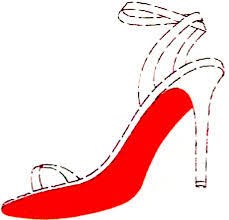Retail Scanner
A shape or colour mark?
Juni 2018
The latest on the Christian Louboutin red sole trade mark. The Christian Louboutin red sole trade mark is one of the most well-known “non-traditional” trade marks, not least because of the scrutiny that it has been subjected to by various courts. In the latest round of litigation which reached the CJEU (The Court of Justice of the European Union) the trade mark registration appears to have survived an attack on its validity.
Christian Louboutin registered a trade mark in Benelux for ‘footwear’ in 2010 and for ‘high-heeled shoes’ in 2013. The trade mark was described as consisting
‘of the colour red (Pantone 18 1663TP) applied to the sole of a shoe as shown (the contour of the shoe is not part of the trade mark but is intended to show the positioning of the mark)’
It was also represented as follows:

Louboutin brought trade mark infringement proceedings in the Netherlands against Van Haren, a shoe retailer. Van Haren counter claimed that the trade mark was invalid. The issue was then referred by the District Court of the Netherlands to the CJEU.
The basic issue that the CJEU had to grapple with was the question of what the trade mark covers; is it the shape of the product, the colour of the sole or a combination of both? If court considered the mark to be a shape mark, then its validity could be questioned on the grounds that the shape gives substantial value to the goods themselves.
Before the CJEU decision it wasn’t looking good for Louboutin. The referring Dutch Court considered that the mark at issue was “inextricably linked to shoe soles” and “covered not only the three-dimensional properties of goods (such as their contours, measurements and volume), but also colours”. The Attorney General’s opinion provided to the CJEU also suggested that the mark could be a shape and colour mark and therefore in theory, the Louboutin red sole mark could be invalid.
However, the CJEU did not agree. It decided that the Louboutin mark did not relate to a specific shape of sole for high-heeled shoes as the description of the mark explicitly states that the contour of the shoe does not form part of the mark and is intended purely to show the positioning of the red colour covered by the registration. The mark was therefore not for a sign that consisted exclusively of the shape of the goods.
The Court said:
“It cannot…..be held that a sign consists of that shape in the case where the registration of the mark did not seek to protect that shape but sought solely to protect the application of a colour to a specific part of that product”.
This case highlights how important it is when applying for non-traditional trade marks to make it very clear as to what the sign is that you are trying to protect. Without the clear description in this case that no protection was sought for the contour of the shoe, it would have been harder for the CJEU to hold that the mark was not a shape mark. The validity of the mark could then have been called into question on the specific grounds that relate to shape marks.
Further, it is important to remember the basic issue that the sign in question must function as a trade mark. It will not have been lost on the CJEU that the referring Dutch Court held that a significant proportion of consumers of women’s high-heeled shoes in the Benelux States were able to identify Louboutin shoes as goods originating from that producer and therefore able to distinguish them from women’s high-heeled shoes from other undertakings. The sign passed the vital test that it is perceived as a trade mark in relation to the relevant goods.





























